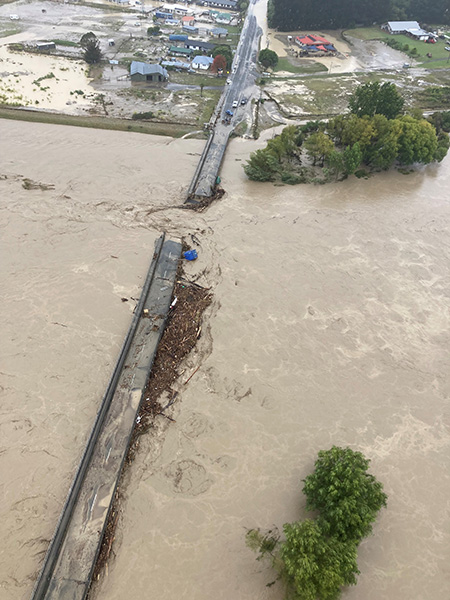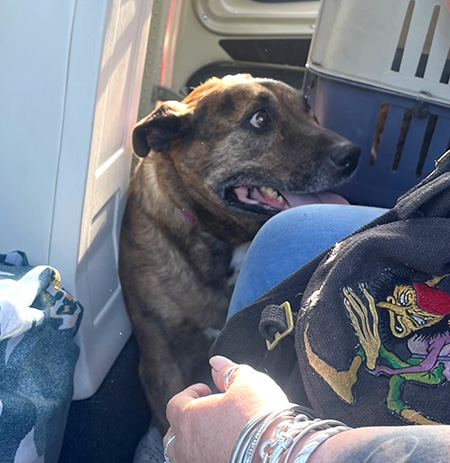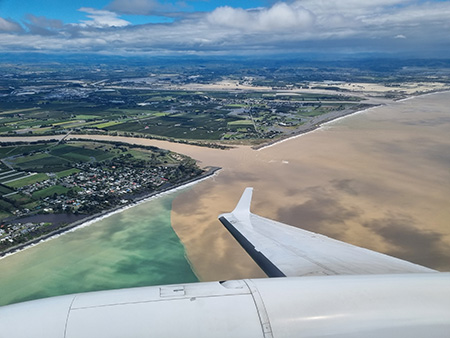 Here’s how local operators at Hawke’s Bay Airport maintained safety in the chaotic aftermath of Cyclone Gabrielle. And what they learned about preparing for the next emergency.
Here’s how local operators at Hawke’s Bay Airport maintained safety in the chaotic aftermath of Cyclone Gabrielle. And what they learned about preparing for the next emergency.
On this page
Mid-morning, Tuesday 14 February 2023, it finally stopped raining. But with up to 720mm of rainfall in the prior 24 hours, large swathes of Hawke’s Bay and Tairāwhiti were devastated.
Napier was an island, cut off by flooded roads and damaged bridges.
At 7am, the power cut out, taking with it all electronic communications. Throughout the day, the waters continued to rise.
Lesson 1: The airport

Waiohiki Bridge - Courtesy of Cam Taylor
Despite 176mm of rainfall in the past day – 56mm is the average for the entire month of February at the aerodrome – the airport was relatively unscathed and remained operational. At 5am on Tuesday, Hawke’s Bay Airport Operations Manager Deb Suisted, began the first of four 16-hour days.1
“Every emergency has its own peculiar challenges,” says Deb, “and you have to be flexible, be ready to make decisions on the spot, and be innovative.
“One of the biggest challenges for us was the complete loss of electronic communications. It affected everyone way more than we really anticipated.
“Our team had radio-telephones so we could reach each other, and the airport had a generator so we could communicate with agencies outside the region. But many local operators didn’t have comms, so it was a matter of walking between my terminal office and their bases, several times a day, to stay in contact.2
The availability of backup power is Deb’s first piece of advice to other airport companies, and airport users.
“It’s absolutely essential. Operators couldn’t pump fuel, ATMs didn’t work, aircraft couldn’t be maintained, and no one could access NOTAM information, or knew what the weather was going to do – all because of no power.”
Lesson 2: One person
Deb would also advise organising a single person, ahead of time, to be the information conduit through which all news of operator problems and activities would pass.
She did her best to be that person, walking around operators a couple of times a day, collecting information, offering her team’s help, and – once electronic comms had been re-established – sending out a daily newsletter updating everyone on where everyone else was at.

Photo courtesy of Skiv Devescovi/Aroha Helicopters.
She was also part of daily civil defence video updates, so could communicate to other agencies what was needed, and find out what was on its way. She put through requests for equipment and services, but could do this only if she knew they were needed.
“So organising someone that everyone knows about, ahead of time, to be the sole channel for information and requests for help would be a good way to go. That person also needs to actively ask each operator what they need.”
Innovation
A number of the ‘roof rescuees’ who arrived at the airport terminal’s pop-up welfare centre were accompanied by dogs as traumatised as them. Some of those dogs didn’t have leashes, so quickly had their owners had to move to the relative safety of the house roof. In anticipation that an anxious dog may suddenly escape airside, leashes were fashioned from the ropes of chocks.
Lessons about internet access

Photo courtesy of Hawke's Bay Airport.
Once it was generally known that the terminal had power, and therefore an internet connection, it was besieged by Napier locals, desperate to communicate with family and friends outside the region.
“People were hugging the power points with multiboards, charging devices,” says Deb Suisted. “At one point, there were more than 600 people connected to our wifi. They were sucking so much bandwidth, I fell off the daily emergency briefing. I asked them all to stay off the wifi for just one hour. Not many obliged and I fell off the call again a few minutes later. So we cut the public's access to our wifi.
“What we learned was that our corporate wifi and public wifi were not separated. In the end, to reduce the number of people in the terminal, we capped wifi use to 30 minutes per device.”
Lessons about power
Two airport-based maintenance facilities had no power. Because of the implication of that for safe rescue and recovery flights, Deb put in a request through civil defence explaining that a large generator connected to a transformer was needed between the two workshops.
“Within 15 minutes, Unison (the central North Island power company) was at the airport, and soon after, power was restored to the whole airport precinct. It may have just been good timing, but it certainly meant safer operations in the cyclone’s aftermath.
“The lesson from this is that you need to think about what others might need, because at times they’re almost too busy to think about it themselves.
“Also, getting power to maintenance facilities is now on our checklist!”
Lesson 3: Risk versus reward
A personal account by pilot Geoff Keighley
My cousin Fiona was the first to ask for help. Her voice message, early on Tuesday morning, was full of panic.
“Mum and Dad are on the roof, can you please help? Please hurry!”
I borrowed a Squirrel helicopter from a local horticulturalist, and the services of the owner’s son, Cam, who knew his way safely around a helicopter, to act as crewman.
I emphasised to Cam that we weren’t going to go in with that ‘we have to save people at any cost’ mindset.
I told him, “We’re potentially going to see some stuff we don’t want to see today. But first and foremost, it’s about you and I getting home tonight.
“And we’re not going to take any unnecessary risks. If you’re not happy about something, or we can’t agree on the safety of something, we don’t do it. It’s that simple.”3
As we became airborne the sheer enormity of the task ahead became apparent. I’d never seen anything quite like this in my 50 years.
Fortunately, my uncle and aunty had already been rescued by boat crews, so we tracked towards Puketapu.
Our first task was to get about 100 RSE (‘recognised seasonal employer’ – mainly from Pacific Island countries) workers to high ground.
They were scattered along the stop banks of the Tutaekuri River. Over several journeys, we flew them to safety – some of them to the local landfill. Not many people can say they’d had a helicopter ride to a rubbish dump, but it was safe ground!
Once the RSE workers were all safe, we continued upstream.

After 11 hours of being increasingly muddied, Geoff and Cam agreed the hot shower afterwards was 'gold'.
My past experiences had conditioned me for days like this. I’ve done more than 20 years flying in Australia and Papua New Guinea – in construction, exploration, bushfire and flood recovery.
But you never totally feel comfortable in these environments – and you shouldn’t. I knew where I could fit the helicopter, and where I couldn’t, what was safe for me to do, and what wasn’t.
We did everything as safely as we could in the circumstances, if not strictly according to the book.4 For example, it was difficult to tightly fasten everyone’s seat belt, due to the water swelling the belts themselves, and mud clogging the fastening mechanisms.
(Cam, however, was able to reach through the helicopter’s open door, and ‘muscle’ the belt tight for the outside seat passenger.)
We loaded and unloaded passengers only from the nontail rotor side of the aircraft. Main rotors are less of a risk than the fast-moving, near-invisible tail rotor blades.
But we assessed each area before we went in. We might have orbited it three, four times before we made a decision on how we were going to approach it – where the powerlines were, how close we’d be getting to trees, then how we were going to land on the building, and how Cam would load the passengers.
We’d talk about how to communicate to the people on the roof to get rid of FOD – blankets and sleeping bags and towels – anything that could be recirculated into the rotors, and then we talked about how we were going to depart out of there. We talked about all of this before we went in.
We worked in tandem with James for a while during the afternoon. That was good because he’s an ag pilot and was very aware of low-level hazards like power lines and trees. He’d hover off and assess the bigger picture as I got in close. It was an added level of situational awareness. Then we’d swap roles, and I’d be extra eyes as he went close in to pick someone up.
We made calls to each other only when we needed to, because the radio was chaotic. You could hardly get a message in edgewise at times.
It was all about assessing the risk and the reward. It wasn’t always easy extracting people – some were very weak from being in water up to their necks for hours, some were really heavy, so keeping the machine steady as they clambered in, took some concentration. A good visual reference helped.
Some of it was quite distressing – little kids in just their underwear, terrified and blue with cold. Their parents visibly shaken and crying. It was really confronting. A couple of times I had to hold back emotion – the sight of children in such distress was something I’ll never forget.
But my mindset was ‘we have to stick to the task of helping these people as best we can’.
Cam worked out that, in the end we’d shuttled about 140 people to safety – some off stock banks, some from roads, and some off rooftops.
Eleven hours after we’d begun, we landed safely. We agreed we’d had a win and it was an astounding and unforgettable day.
It was also a day of sheer kindness, as strangers helped our passengers, offering them shelter and food, and most importantly, compassion.
Lesson 4: The saviour of the day
As recreational aircraft from outside the region started to fly in, carrying supplies for friends and family, the airspace across the whole region became busy – even dangerous. The number of flights to Hawke’s Bay Airport in January increased by 300 percent in February (and by 350 percent in March).
In the very early days, some of the pilots had not planned well for their flight, so focussed were they on getting through with their precious generator or other supplies as fast as possible.
Some allegedly made no radio calls, no position reports, and just ‘appeared’ inside restricted airspace.

Flood meets ocean - Courtesy of Skyline Aviation
“So one of the biggest saviours of the day,” says local LAME Rob Mudgway, “was, without doubt, ADS-B”.
Rob, CEO of Red Airworx, believes ADS-B was the reason there wasn’t a disaster in the air in the postcyclone commotion.
“There was so much going on in a relatively small airspace. There were helicopters hovering and rescuing people, helicopters transiting to and from Hastings, Napier and surrounding areas, and the weather conditions at times were not ideal.
“ADS-B allowed aircraft to see one another, alerting pilots of aircraft flying near them.
“Even me, flying back from a maintenance job in Gisborne – I’d just look at all the traffic on my device and go, ‘Oh well, I’ll just put my life jacket on and stay out off the coast and completely away, talk to the tower and they’ll just bring me in when they can. Easy.
“ADS-B is a game changer. It should be mandatory for every aircraft in New Zealand.”
Over at charter and training operator, Aroha Helicopters, its CEO and chief pilot Skiv Devescovi, agrees.
Skiv spent the first few days, post-cyclone, ferrying essential goods and generators to stranded, rural properties.
He flew almost triple his normal number of flights over the first two days, amidst a huge number of aircraft on cyclone recovery missions – but says almost everyone had ADS-B, and that made a huge difference.
“Even if they didn’t put in the radio calls, you could see them, and that was great in such busy airspace.”
Dylan Robinson, from the New Zealand Air Ambulance Service – Skyline Aviation – is also a fan.
“Particularly on the first weekend post-cyclone, we saw a lot of recreational pilots coming into the Hawkes Bay from all around the country bringing in care packs and supplies.
“That’s where we saw the benefits of ADS-B. On a few occasions, we noted aircraft making incorrect or no position reports, but because they had ADS-B, we could see them on TCAS – that definitely helped us avoid a few dangerous situations.”
Footnotes
1 Rising water levels meant Deb was evacuated from her home at 10.30pm that night. She arrived at the airport with her husband, sleeping bags, pillows, and a crockpot. They were to remain there for four days.
2 Despite recent knee replacement surgery, Deb walked about 18,000 steps each day in the first four days. “I just upped the meds, and got on with it.”
3 After the brief, I looked down, surprised to see Cam was barefoot, I said, “Mate, that’s not going to work!” He’d run from his house with only the clothes he was wearing. Fortunately, I had a pair of jetboat booties in my vehicle which he somehow managed to fit. Turns out the booties were Cam’s best friend, as he traversed, Spider Man-like, across slippery roofs!
4 Vector comment: After his flights, Geoff submitted an s13A notification to the CAA. Section 13A of the Civil Aviation Act 1990 exempts pilots from the rules in some emergency situations – in this case, because people were in danger.
This is the end of the first part of the Lessons from the cyclone article. To read the second part, see Lessons from a cyclone - part 2.
